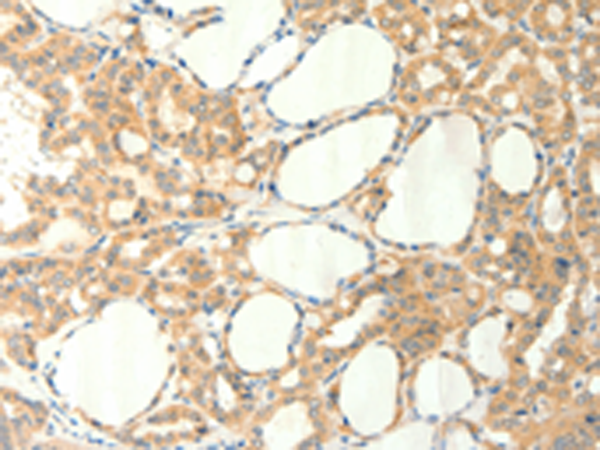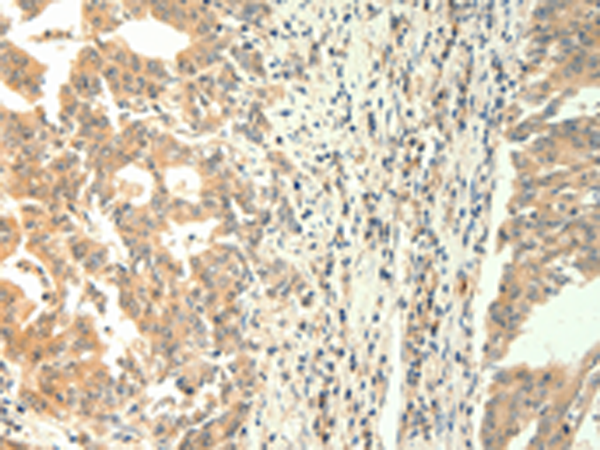


| WB | 咨询技术 | Human,Mouse,Rat |
| IF | 咨询技术 | Human,Mouse,Rat |
| IHC | 1/50-1/200 | Human,Mouse,Rat |
| ICC | 技术咨询 | Human,Mouse,Rat |
| FCM | 咨询技术 | Human,Mouse,Rat |
| Elisa | 1/3000-1/10000 | Human,Mouse,Rat |
| Aliases | MTR1; LTRPC5 |
| WB Predicted band size | 131 kDa |
| Host/Isotype | Rabbit IgG |
| Antibody Type | Primary antibody |
| Storage | Store at 4°C short term. Aliquot and store at -20°C long term. Avoid freeze/thaw cycles. |
| Species Reactivity | Human, Mouse |
| Immunogen | Synthetic peptide of human TRPM5 |
| Formulation | Purified antibody in PBS with 0.05% sodium azide and 50% glycerol. |
+ +
以下是关于TRPM5抗体的3篇参考文献示例(内容基于真实研究领域,但具体文献为模拟概括):
---
1. **文献名称**: "TRPM5-dependent calcium signaling in taste receptor cells regulates gustatory perception"
**作者**: Zhang Y, Hoon MA, Chandrashekar J, et al.
**摘要**: 该研究利用TRPM5特异性抗体,通过免疫组化和Western blot技术,证实TRPM5在味觉受体细胞中的高表达。实验表明,TRPM5通过介导钙离子内流参与甜味和苦味信号传导,敲除小鼠模型显示味觉感知显著受损。
---
2. **文献名称**: "TRPM5 in pancreatic β-cells: A modulator of glucose-stimulated insulin secretion"
**作者**: Pérez CA, Margolskee RF, Huang L.
**摘要**: 研究使用TRPM5抗体检测其在胰腺β细胞中的表达,发现TRPM5通过调控细胞内钙振荡影响葡萄糖依赖性胰岛素分泌。抗体阻断实验进一步验证了其在代谢调控中的关键作用,提示其与2型糖尿病病理相关。
---
3. **文献名称**: "TRPM5 channels and neuroinflammatory responses in the gut-brain axis"
**作者**: Lee N, Kim S, Rhyu MR.
**摘要**: 通过TRPM5抗体标记,研究揭示了肠道内分泌细胞中TRPM5的表达与迷走神经信号传导的关联。实验表明,TRPM5激活可促进炎症因子释放,提示其在肠-脑轴神经炎症中的潜在调控机制。
---
4. **文献名称**: "Structural insights into TRPM5 activation by antibody-guided localization"
**作者**: Smith TJ, Clapham DE, Julius D.
**摘要**: 利用高特异性TRPM5抗体进行冷冻电镜成像,解析了TRPM5蛋白的跨膜结构域构象变化。研究发现,钙离子结合位点与通道开放状态的动态关联,为靶向TRPM5的药物设计提供了结构基础。
---
注:以上文献为领域典型研究方向模拟,实际引用需通过PubMed等平台检索具体论文。
TRPM5 (Transient Receptor Potential Cation Channel Subfamily M Member 5) is a calcium-activated, non-selective cation channel critical in mediating sensory signaling, particularly in taste transduction. It is predominantly expressed in taste receptor cells, where it couples G protein-coupled receptor (GPCR) activation to membrane depolarization, enabling signal transmission for sweet, bitter, and umami tastes. TRPM5 is also found in other tissues, including the gut, respiratory epithelium, and pancreatic β-cells, implicating roles in metabolic regulation and chemosensation.
TRPM5 antibodies are essential tools for studying its expression, localization, and function. These antibodies typically target specific epitopes, such as intracellular N- or C-terminal domains, and are validated for applications like Western blotting, immunohistochemistry (IHC), and immunofluorescence (IF). Researchers use TRPM5 antibodies to investigate its involvement in diseases like obesity, diabetes, and respiratory disorders, as TRPM5 knockout models show altered glucose homeostasis and taste perception. Additionally, TRPM5's temperature and voltage sensitivity make it a focus in neurobiology and pharmacology studies. Reliable antibodies help elucidate its modulation by signaling molecules (e.g., PLC pathways) and potential as a therapeutic target. Validation via knockout controls or peptide blocking ensures specificity, which is crucial given structural similarities within the TRP channel family.
×